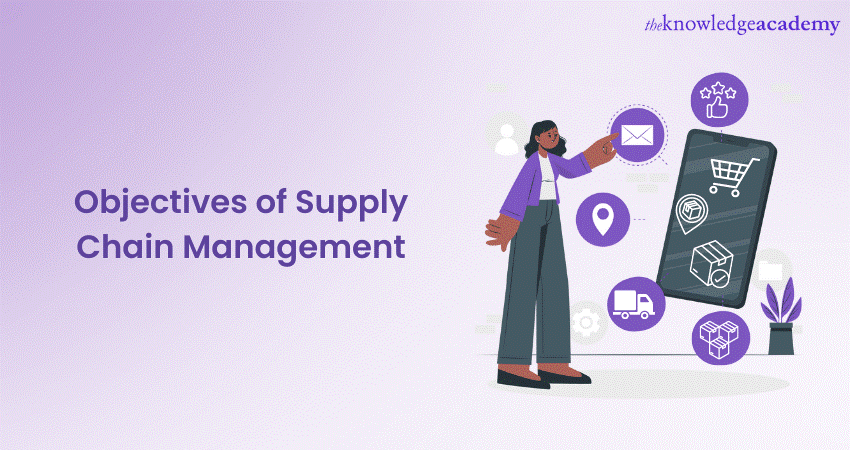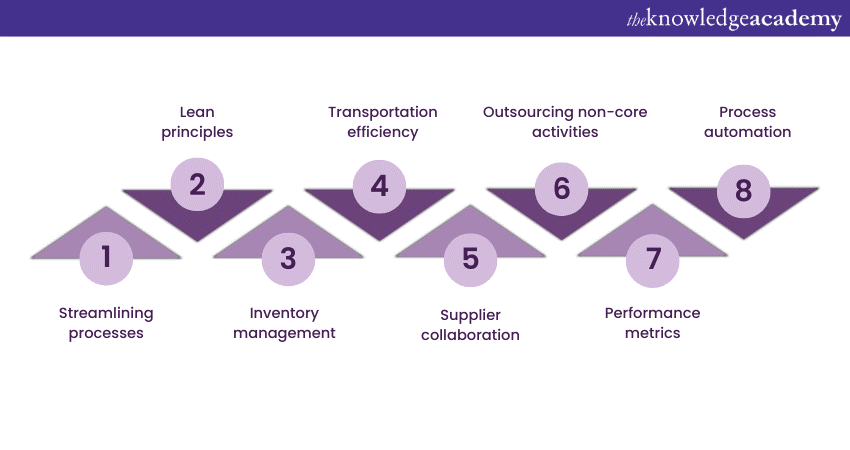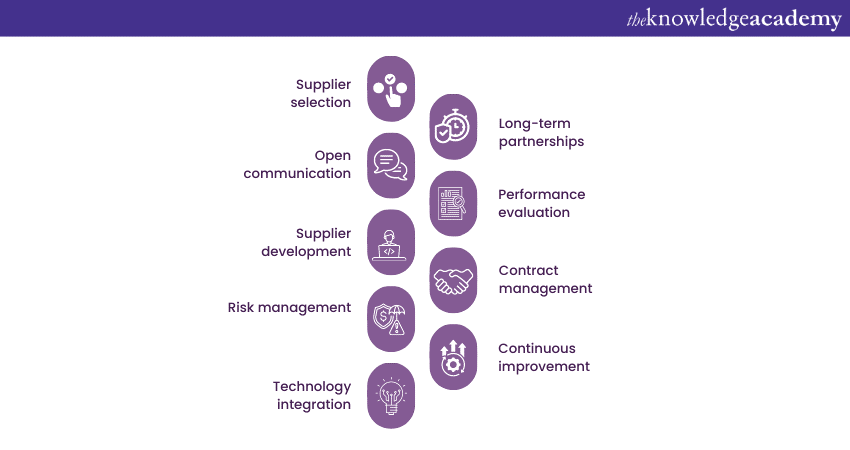We may not have the course you’re looking for. If you enquire or give us a call on 01344203999 and speak to our training experts, we may still be able to help with your training requirements.
Training Outcomes Within Your Budget!
We ensure quality, budget-alignment, and timely delivery by our expert instructors.

Supply Chain Management play a crucial role in the success of businesses across various industries. Therefore, understanding the Objectives of Supply Chain Management is fundamental to achieving efficiency, reducing costs, and delivering value to customers.
Supply Chain disruptions can wreak mayhem on the productivity and profitability of a business. According to Statista, businesses worldwide suffer losses worth 145 million GBP annually. Thus, understanding the Supply Chain Management Objectives can help you avoid such disruptions. In this blog, you will learn what are the Objectives of Supply Chain Management in great detail. Let’s dive in deeper to learn more!
Table of Contents
1) Understanding the Objectives of Supply Chain Management
2) What are the various Objectives of Supply Chain Management?
a) Cost reduction and efficiency enhancement
b) Inventory management
c) Improved customer service
d) Supplier Relationship Management (SRM)
e) Risk Mitigation and Resilience
f) Sustainability and social responsibility
g) Innovation and technology integration
h) Market expansion and global reach
3) Conclusion
Understanding the Objectives of Supply Chain Management
Supply Chain Management (SCM) aims to optimise processes and ensure seamless coordination among various stakeholders involved in the Supply Chain. The primary objective of SCM is to create a competitive advantage for the organisation by delivering value to customers. At the same time, it is also about maximising efficiency and minimising costs.
Unlock your full potential with our industry-leading Industry Training – Sign up today!
What are the various Objectives of Supply Chain Management?
Supply Chain Management encompasses a set of goals and objectives that organisations. They help optimise their Supply Chain operations and gain a competitive advantage. Let’s explore the Objectives of Supply Chain Management:
Cost reduction and efficiency enhancement
Cost reduction and efficiency enhancement are primary Objectives of Supply Chain Management that organisations continually strive to achieve. Businesses can maximise output while minimising expenses by optimising the Supply Chain Management Process. Here are key approaches to attain these objectives:

1) Analyse and re-engineer existing processes to eliminate inefficiencies and bottlenecks, reducing lead times and improving productivity.
2) Apply Lean principles to eliminate waste and improve Supply Chain agility.
3) Optimise inventory levels through demand forecasting and just-in-time inventory practices to reduce carrying costs.
4) Negotiate favourable contracts with carriers, optimise routing, and explore transportation options to minimise costs while ensuring timely deliveries.
5) Collaborate with suppliers on demand forecasting, production preparation, and inventory management to reduce lead times and costs.
6) Outsource non-core activities to specialised service providers to focus on core competencies and gain efficiencies.
7) Implement KPIs and performance metrics to monitor Supply Chain effectiveness and identify areas for improvement.
8) Integrate technology solutions like robotics and automated systems to reduce errors and increase operational efficiency.
Inventory management
Effective management of inventory is a crucial aspect of Supply Chain Management. It aims to achieve a delicate balance between meeting customer demand and minimising carrying costs. Let’s explore the key approaches to successful inventory management:
1) Demand forecasting: Accurate forecasting enables optimised inventory levels and prevents stockouts or overstock situations.
2) Just-in-time (JIT) inventory: Adopting JIT principles reduces holding costs by delivering products as needed.
3) Safety stock: Maintaining safety stock mitigates the risk of unexpected demand fluctuations or delays from suppliers.
4) Inventory turnover: Measuring turnover helps assess the efficiency of inventory utilisation.
5) ABC analysis: Categorising inventory based on value enables prioritisation for better management.
6) Vendor-managed inventory (VMI): Suppliers monitor and manage inventory levels on behalf of the organisation, reducing stockouts.
7) Economic order quantity (EOQ): Calculating the optimal order quantity minimises order and holding costs.
8) Inventory audits: Regular audits ensure accurate inventory records and identify discrepancies.
9) Technology integration: Implementing inventory management software enhances visibility and control over inventory levels.
Improved customer service
Improved customer service is a key objective of Supply Chain Management, as it directly impacts customer satisfaction and loyalty. By focusing on providing exceptional service throughout the Supply Chain, organisations can gain a competitive advantage and foster long-term relationships with their customers. Let’s explore the key approaches to achieving improved customer service:
1) Timely deliveries: Ensuring products reach customers on time, meeting their expectations.
2) Accurate order fulfilment: Minimising errors in order processing and shipping.
3) Responsive customer support: Promptly addressing customer inquiries and issues.
4) Effective communication: Keeping customers informed about their orders and any potential delays.
5) Efficient returns handling: Streamlining the process for product returns and exchanges.
6) Personalisation: Tailoring services to individual customer needs and preferences.
7) Customer feedback: Accumulating and acting on customer feedback to continuously improve service.
8) Supply Chain visibility: Providing customers with real-time updates on the status of their orders.
9) Collaboration with partners: Coordinating with suppliers and logistics partners to enhance service levels.
Unlock the potential for seamless Supply Chain operations with our Logistics Management Training – Sign up now!
Supplier Relationship Management (SRM)
SRM is one of the critical Objectives of Supply Chain Management, focusing on establishing and maintaining positive and collaborative relationships with suppliers. Effective SRM enhances the overall efficiency and resilience of the Supply Chain and contributes to the success of the organisation. Let’s explore the key approaches to successful supplier relationship management:

1) Carefully evaluating potential suppliers based on factors such as reliability, quality, and financial stability.
2) Building strong, long-term relationships with selected suppliers fosters trust and loyalty.
3) Maintaining open lines of communication with suppliers to facilitate timely and effective collaboration.
4) Regularly assessing supplier performance based on pre-defined Key Performance Indicators (KPIs) and benchmarks.
5) Collaborating with suppliers to improve their capabilities, efficiency, and quality.
6) Creating clear and mutually beneficial contracts that outline expectations and responsibilities.
7) Recognising and mitigating potential risks associated with suppliers, such as disruptions or quality issues.
8) Encouraging suppliers to adopt continuous improvement practices for mutual benefit.
9) Leveraging technology for seamless information exchange and real-time visibility into supplier operations.
Risk mitigation and resilience
Risk mitigation and resilience are vital to Supply Chain Management Objectives that address potential risks and disruptions. Let’s explore the key approaches to achieve these objectives:
1) Risk assessment: Identifying and evaluating potential risks in the Supply Chain like natural disasters or supplier disruptions.
2) Contingency planning: Developing comprehensive plans to address different risk scenarios and ensure a swift response.
3) Diversification: Reducing dependency on single suppliers or markets by diversifying sourcing options.
4) Business continuity: Implementing robust plans to ensure minimal disruptions during crises.
5) Supplier risk management: Assessing and monitoring risks associated with key suppliers.
6) Real-time monitoring: Using technology and data analytics to detect potential risks in real time.
7) Flexibility and agility: Building a flexible and Agile Supply Chain that can adapt quickly.
8) Scenario planning: Conducting exercises to anticipate and prepare for potential risks.
9) Collaboration: Collaborating with stakeholders to jointly address risks and find solutions.
A resilient Supply Chain can navigate challenges and disruptions effectively, safeguarding operations in an unpredictable business environment.
Sustainability and social responsibility
Sustainability and social responsibility are other critical Objectives of Supply Chain Management. Organisations strive to minimise their environmental impact and promote ethical practices using Green Supply Chain Management. Here is how you can achieve that:
1) Environmental sustainability: Reducing carbon footprint, promoting eco-friendly practices, and responsible sourcing.
2) Social responsibility: Ensuring fair labour practices, supporting ethical working conditions, and promoting diversity.
3) Green Supply Chain Management: Implementing eco-friendly initiatives like energy-efficient operations and recycling.
4) Responsible sourcing: Sourcing raw materials responsibly to support sustainability goals.
5) Ethical standards: Adhering to ethical standards throughout the Supply Chain.
6) Consumer appeal: Attracting environmentally conscious customers through sustainable practices.
7) Brand image: Enhancing the brand image by demonstrating a commitment to sustainability.
8) Stakeholder engagement: Collaborating with stakeholders to achieve sustainability objectives.
9) Impact assessment: Evaluating the environmental and social impact of Supply Chain operations.

Innovation and technology integration
Innovation and technology integration are crucial Objectives in Supply Chain Management. Embracing cutting-edge technologies like data analytics, automation, and IoT enables real-time decision-making, enhances efficiency, and drives continuous improvement. Organisations gain a competitive advantage by leveraging innovation to optimise Supply Chain operations and meet client expectations.
Market expansion and global reach
Market expansion and global reach make the key Objectives of Supply Chain Management. Organisations aim to explore new markets and expand their customer base internationally. By establishing efficient global Supply Chain networks, you can tap into international opportunities and gain access to diverse markets. It also helps achieve sustainable growth in the global marketplace.
Supply Chain Management is a multi-layered discipline that involves pursuing various interconnected objectives. Achieving these Supply Chain Management goals and objectives leads to efficient and resilient Supply Chains. It also enables organisations to deliver value to customers, gain a competitive advantage, and drive business success.
Conclusion
We hope you read and understand everything about the Objectives of Supply Chain Management. By prioritising these objectives, organisations can build adaptive, sustainable, and thriving Supply Chains in the dynamic global marketplace. Embracing a strategic and holistic approach to Supply Chain Management paves the way for growth, innovation, and long-term success.
Transform your Supply Chain expertise with our specialised Supply Chain Management Training – Sign up now!
Frequently Asked Questions
Upcoming Business Skills Resources Batches & Dates
Date
 Supply Chain Management Training
Supply Chain Management Training
Fri 7th Jun 2024
Fri 6th Sep 2024
Fri 6th Dec 2024







 Top Rated Course
Top Rated Course


 If you wish to make any changes to your course, please
If you wish to make any changes to your course, please


